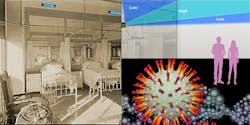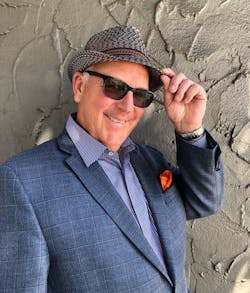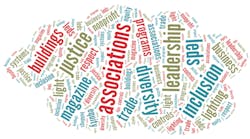Strategies in Light has always been about the interplay between fundamental technologies and their applications and markets, and this year’s conference is no different. One of the emerging technologies in solid-state lighting (SSL) is ultraviolet, particularly in germicidal applications. Interest in UV-C LEDs was certainly compelled by health concerns and indoor air and surface disinfection over the past year-plus. However, the market outlook and application of these solutions appears to be up for debate!
This August, we will host several talks on UV technology and a panel discussion about its application. First, Mike Krames, president of Arkesso, LLC, will discuss the UV-C technology roadmap. Ling Zhou, CEO of Bolb, Inc., will discuss the technology and applications of high-performance UV-C LEDs with transparent p-Ohmic contact layers. Finally, Seth Coe-Sullivan, CEO and president of NS Nanotech, will discuss shortwave light and far UV-C semiconductor devices.
According to others, the development path for UV looks very different than that of the original blue-pump LED. A driving principle of Strategies in Light has always been to present actionable intelligence from multiple perspectives in order to drive the SSL industry to improve performance and apply advanced technologies to the built environment.
The panel discussion “Germicidal Applications of UV-C Technology” will present a robust counterpoint to arguments about fundamental technology driving the market and applications. Moderated by Bob Karlicek, director of the Center for Lighting Enabled Systems & Applications (LESA), and featuring speakers Mark Stibich, founder and chief scientific officer at Xenex; Tom Boyle, chief technology officer, GE Current; and Gary Trott, vice president of technology commercialization at Acuity Brands, the panel will explore crucial questions about the potential market for the technology, key differences between existing and new solutions, and unintended consequences of its implementation. I recently talked to Bob Karlicek about what he saw as the important points to cover in the panel session.
Bob has already made some clarifications about the current state of UV-C technology in the pages of LEDs Magazine, but he offered a few more points during our conversation. UV-C is primarily used in buildings in three basic application areas — upper air, surface disinfecting, and integrated into HVAC ducts for air disinfection. While xenon light sources are used in some systems, Hg lamps are the primary lighting technology currently employed in air ducts. According to Bob, “LED lifetimes are still short relative to mercury lamps; mercury lamps have the highest efficiency of producing UV-C radiation — they can be up to 30% efficient.” He continued, “Right now, LEDs really aren’t being used in HVAC systems. They’re too expensive, too small, they don’t have enough output power, and they’re not reliable enough.”
As Maury Wright has covered in a recent series on GUV, upper-air systems have seen a lot of interest for disinfecting pathogens beyond SARS-CoV-2, and Bob echoed some of the background cited in that article regarding their use in hospitals and clinical environments, especially where tuberculosis was prevalent. “The systems used to be very common in US hospitals in the 1940s, ’50s, and ’60s. They removed the systems with the advent of antibiotics, thinking that they weren’t needed anymore. This was before antibiotic-resistant bacteria emerged. So these systems have been around forever, and people stopped using them because they thought they had pharmacological solutions,” he said. Now that COVID-19 vaccines are prevalent, it’s worth considering that a similar calculation will be made today.
Still, UV-C is not in widespread use for contemporary HVAC systems. “When I took a look around for UV-C systems that could be put into air ducts, there are very few companies that actually sell them and have data around how effective they are, especially given the air velocities in ductwork, to be able to do experiments that demonstrate how effective it is against say, aerosols, that contain viruses. It may make a comeback, but I’m not sure,” said Bob.
On the question of specific UV wavelengths, it’s safe to say there can be confusion about the definitions and relative applications of UV-C, what’s being called far-UV (particularly 222 nm), and visible-light radiation around 405 nm, which is being touted for continuous disinfection due to its safety profile with occupants in the space.
“For a long-term disinfection modality, think suppressing fungi and bacteria growing in your shower,” explained Bob. “Think bathrooms on aircraft, food processing facilities, where you can basically just suppress the propagation of bacteria and fungi. I think that that’s going to be a viable application of 405 technology — maybe some of these other technologies as well, but particularly 405.” He noted, “It’s slow, but you use it in places where you don’t need to instantaneously disinfect. With regard to 405 and COVID, I don’t believe that will ever be effective. It’s too slow especially for viruses like SARS [that causes the COVID-19 illness].” Read a recent column by Maury Wright for more on what is and isn’t likely possible with 405-nm light.
To define the term “far UV-C,” Bob said, “I would make the argument that it’s anything between 200 and 230 nm.” I asked him if there was anything special about 222 nm versus, say, 230 nm. He responded, “No, it’s a matter of gradation. With longer wavelengths, the penetration depth into human tissue and eyes gets higher. As you go to longer wavelengths, you gradually diminish the claims of human safety. I think a gradual transition to 222 will be better than 230, and 230 will be better than 240. And by the time you get up to 250 or 254, all bets are off. You don’t want to be there for long-term human exposure — not for eyes and not for skin. So it’s a question of degree. It’s a question of what tradeoffs we’re willing to tolerate.”
Bob’s perspective on the UV-C LED potential is different than Krames’ and is focused on application in the built environment as well as on the technology trajectory. “LEDs will just gradually start off at increasingly shorter and shorter wavelengths, but as their wavelengths come down from typically where UV-C LEDs are available right now at 275 nm, they get lower and lower in terms of power output, and of course less economically viable, he said.
There are good arguments for an accelerated UV technology development track given the recent history of SSL development. But’s possible that UV LEDs will not tread that same path. Difficult application questions remain, along with the high cost when considered against power and efficiency characteristics. During this panel discussion at Strategies in Light, panelists will be asked to address critical points such as the following:
- Now that the pandemic is apparently waning, to what degree will different technologies have an ongoing and or even growing application?
- In combating microbes spread by touch versus pathogens spread by aerosols, how does your technology apply in these particular spaces?
- What are the ramifications for long-term impacts in the built environment such as damage to materials, possible generation of volatile organic compounds, and other unintended consequences? Is it possible we will create spaces that are too sterile?
- How do we deal with the distinct challenges of specification, installation, operation, and maintenance for more complex UV-C and lighting controls systems, not to mention the codes and regulations necessary to ensure safety and cost effectiveness?
I also asked Bob to elaborate on unintended consequences and other possibilities, including potential spinoffs or other innovations he could see.
“I think UV LEDs could be very interesting for controlled environment agriculture, in the suppression of mold growth in places where crops are increasingly being grown indoors. There may be environments where you need to suppress various virus and fungal things that attack crops, and these technologies would be valuable there,” Bob observed.
He continued, “Ultimately, it comes down to the sources — they could be useful for advanced sensing technologies, in high-margin, small markets where you can build UV sources for detecting bacteria and viruses, and things like that using fluorescence or other kinds of modalities. It’s going to be really interesting to see where this goes.
The last comment reminded me that a crucial goal of science is to make sure we’re solving the right problems in the first place! Sometimes we can’t know this in advance, but we have to try. Most groundbreaking innovations were in the application of technologies that were developed to address entirely different problems than they ended up solving. Sometimes the most important question to ask is: “Why should we be doing this?”
Register now to join us for Strategies in Light, which will be held online from Aug. 24–25, 2021, to explore UV-C technology and more.
CLIFTON STANLEY LEMON is CEO, Clifton Lemon Associates, and Strategies in Light co-chair.
For up-to-the-minute LED and SSL updates, why not follow us on Twitter? You’ll find curated content and commentary, as well as information on industry events, webcasts, and surveys on our LinkedIn Company Page and our Facebook page.







